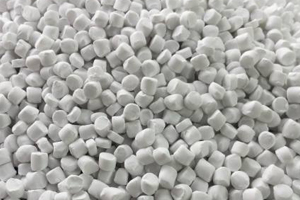PP Calcium Carbonate Compound (PP with CACO3)

Calcium carbonate accounts for more than 4% of the earths crust. As a result, the three calcium carbonate minerals – calcite, aragonite and vaterite – are among the most important rock-forming minerals. Rocks are not the only calcium carbonate deposits in nature – almost all stretches of water and countless plants and animals contain huge amounts of calcium carbonate as well. These natural resources are linked by the calcium carbonate cycle.
Plants and animals absorb calcium carbonate in water, where it usually exists dissolved in the form of calcium hydrogen carbonate Ca(HCO3)2, and use it to build up their skeletons and shells. After their death, mussels, coccoliths, algae and corals form sedimentary deposits on sea beds and the rock-forming process is set in motion.
The first stage is the sedimentation process, from which chalk and limestone originate. Chalk is a poorly compacted sedimentary calcium carbonate rock whose diagenesis is incomplete.
A completed sedimentation process results in the formation of limestone. If the sedimentation process takes place in water containing magnesium, dolomitization may occur. Part of the calcium ions in the crystal lattice are replaced by magnesium ions, leading to the formation of dolomite (CaMg(CO3)2).
Marble is a metamorphic rock resulting from the recrystallization of limestone under high pressure and temperature. Whether chalk, limestone, dolomite or marble, all carbonate rocks are subject to erosion. These dissolve under the influence of wind, temperature and water, and the cycle is ready to start anew.
Modify physical property of plastics, act as plastical modifier.
Replace petroleum resource, reduce production cost. Environmentally friendly.
Improve printability, smoothness, hardness, stiffness, anti-block...
PP calcium carbonate compound: used for PP film blowing, PP sheet extrusion, PP pipe extrusion, PP yarn spinning, PP injection moulding, PP bottle blowing, PP non-woven fabric/fibre weaving..., one of compounds modifying polypropylene/homo PP/copolymer PP resin.
- Processed by the four paddle rotor internal batch mixer or twin screw extruder.
- Calcium carbonate master batch for transparent HDPE film available now. Adding by 5-10%, transparency becomes better in some cases; adding by 10-30%, transparency is still good enough. Its also good for LDPE film, HDPE pipe and PP sheet, which are transparent, but not very transparent.
- Rub the film, CaCO3 (powder) and/or talc (powder) are not found.
- Pellet is round and flat in shape, smooth feeling, well plastified, good dispersibility.
- Ideal additive, harmless, no toxin.
- Save cost, reduce expenditure, strengthen competition.
- Professional process: CaCO3 (powder) and/or talc (powder) are coated and activated by unique coupling agent, dispersant and plasticizer before CaCO3 (pellet) and/or talc (pellet) are produced.
- Special formula: CaCO3 compound and/or talc compound do not apparently side effect physical property of PE film, sometime the tensile strength of PE film becomes better after adding CaCO3 compound and/or talc compound.
- Plastic calcium carbonate compound named as CaCO3 filler compound,CaCO3-filled agent,CaCO3 composite,CaCO3 extender,CaCO3 pellet.
- EVA grade, PVC grade, nylon grade, tubing & Pipe grade and non-woven fabric grade available as well.
- Adding ratio recommended for reference only, please adjust it up or down based on experiment and experience.
- Refer to "ingredients" above, if carrier is LDPE, it does not mean its suitable for LDPE bag only; if carrier is HDPE, it does not mean its suitable for HDPE bag only.
Benefits of Using Transparent Calcium Carbonate Masterbatch
- Maintain the transparency of polymer, keep optical properties almost intact.
- Prevent slitting & folding of tapes in tape lines from splitting in machine direction.
- Offer extremely good dispersion with any polymer.
- Impart certain degree of roughness to extruded/blown film & thereby improve the anti-slip & anti-blocking property of film surface.
- Cost reduction when used as a polymer extender.
- Improved sealibility in extruded film.
- Improve physical properties like hardness, stiffness & impact strength in extruded film.
- Decrease extruder torque & increase machine throughput between 5 to 10%. Reduce the energy cost per kg, thereby reduce processing costs.
- Replace some of petroleum resources, reduce the burning-heat of finished goods, so that the Burners life-span becomes longer. This reduces energy consumption.